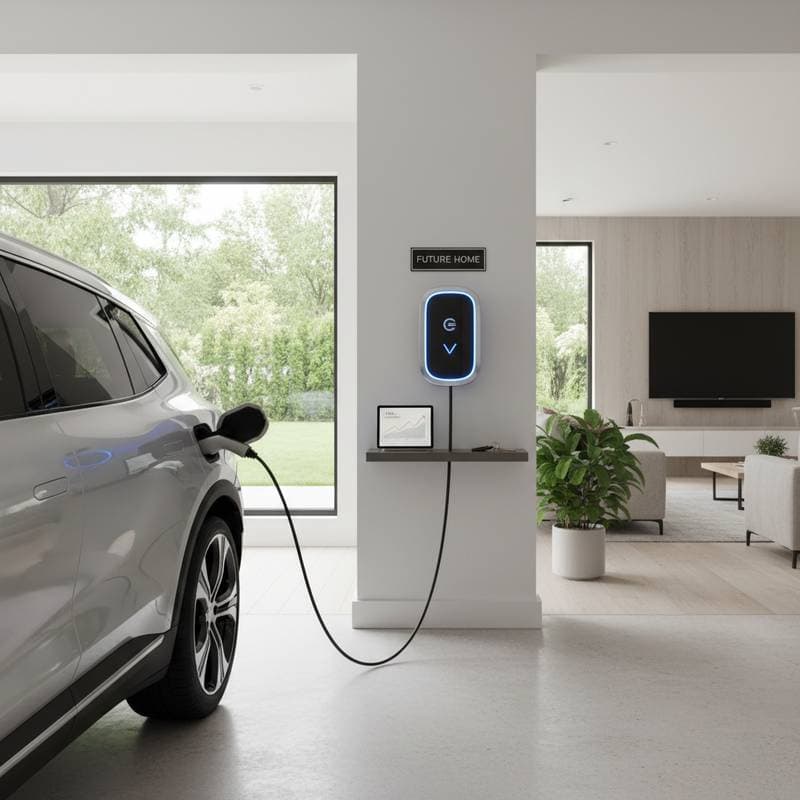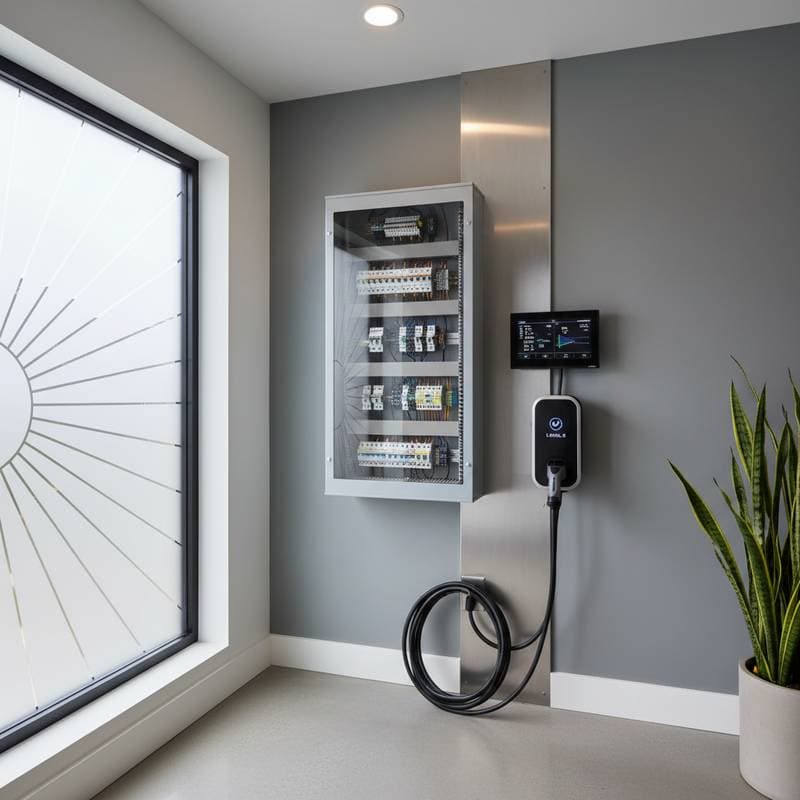EV Chargers Add $10,000 to Home Value in 2025
Installing a home EV charger can increase property value by approximately $10,000. Prospective buyers seek properties equipped with charging infrastructure, which leads to quicker sales and higher offers. The installation expense represents less than half of this potential gain, resulting in a favorable financial outcome.
Reasons EV Chargers Enhance Home Value
Electric vehicles have become commonplace. Numerous buyers currently own one or intend to purchase one soon. A pre-installed charger addresses a primary concern for these individuals: access to dependable charging facilities. Consequently, the property gains greater appeal and commands a higher market price.
Home searchers frequently apply filters for listings that include EV chargers. Real estate professionals report that such properties receive more viewings and experience fewer reductions in asking price. The advantages are straightforward: enhanced convenience, reduced fuel expenses, and an indication that the residence aligns with future trends.
Renters also value this feature. Property owners increasingly add chargers to draw committed tenants and support elevated rental rates. This value enhancement extends to single-family residences, condominiums, and multi-unit developments.
Installation Process for a Home EV Charger
Placement options include garages, carports, or designated outdoor parking areas. A qualified electrician typically completes the installation within a single day.
Key Steps
- Evaluate the electrical panel. Verify sufficient capacity for a new 240-volt circuit.
- Select an appropriate charger. Level 2 models provide optimal speed relative to expense.
- Engage a licensed electrician. The professional assesses load requirements, installs wiring, and secures the unit in compliance with safety standards.
- Obtain necessary permits. Local regulations in many areas mandate this step; neglecting it may lead to inspection failures.
- Conduct testing and registration. Ensure the charger integrates seamlessly with the vehicle and any associated mobile application.
Homeowners generally complete the entire process, including inspections, in one to two days.
Expected Costs
The following outlines typical expenses for installing a home EV charger. Variations occur based on geographic location and existing electrical configuration.
| Task | Typical Cost | Factors Influencing Price |
|---|---|---|
| Level 1 charger (standard outlet) | $300 - $600 | Basic plug-in setup with minimal wiring |
| Level 2 charger unit | $500 - $1,200 | Inclusion of smart capabilities, brand quality, and environmental durability |
| Electrical work and labor | $700 - $2,000 | Distance from panel, surface materials, and permit expenses |
| Total installation | $1,200 - $3,200 | Charger performance level and regional labor rates |
Factors That Increase Expenses
- Extended wiring distances from the electrical panel to the installation site
- Excavation required for outdoor electrical lines
- Necessity to modernize an outdated or insufficient electrical panel
- Advanced chargers featuring Wi-Fi connectivity or energy management systems
Strategies to Minimize Expenses
- Proximity of the electrical panel to the parking location
- Straightforward indoor installation without structural modifications
- Utilization of an existing 240-volt outlet, provided it meets code requirements
Even at the upper range of costs, the investment remains well below the anticipated rise in property value. This positions the EV charger as one of the most efficient upgrades for those pursuing environmentally conscious enhancements.
Installation Timeline
Standard projects require one full workday. Delays may arise from panel upgrades or permit processing, extending the timeline by an additional day or two. Hands-on labor typically spans four to six hours, with testing and inspection adding minimal time.
Elements That Accelerate Completion
- Unobstructed access to the electrical panel
- Indoor parking facilities
- Pre-secured permits or an electrician experienced with regional codes
Elements That Prolong Completion
- Exterior excavation or protective conduit installation
- Scheduling constraints for inspections
- Limited panel capacity necessitating expansions
From initial consultation to operational charger, the process seldom exceeds one week.
DIY Installation Versus Professional Service
Suitable for DIY
- Presence of an existing 240-volt outlet in the garage
- Proficiency in mounting hardware and making connections
- Local regulations permitting unpermitted plug-in setups
Recommended for Professional Handling
- Requirement for new wiring or dedicated circuits
- Full or obsolete electrical panel
- Outdoor placements or installations penetrating finished surfaces
Advantages of Professional Installation
- Accurate determination of electrical load
- Proper integration of circuit breakers and protective conduits
- Management of permits and coordination of inspections
Considerations for Warranties and Compliance
Manufacturer warranties often stipulate professional installation. Unauthorized electrical modifications may invalidate insurance policies or pose hazards. Verify all local stipulations prior to commencing work.
Essential Tools and Materials
The requirements remain straightforward. Most individuals need only basic items.
- Wall-mounted EV charger unit
- Secure mounting hardware including screws and anchors
- 240-volt receptacle or direct wiring setup
- Protective conduit and connectors
- Appropriately rated electrical wire
- Voltage detection device
- Power drill and screwdriver set
- Additional circuit breaker for new circuits
Electricians provide the majority of these components, though familiarity with the elements aids in overseeing the installation.
Considerations for Regions and Climates
Colder Regions
Select units designed for subzero conditions. Certain models incorporate heating elements to maintain cable pliability.
Warmer or Humid Environments
Opt for sealed, ventilated housings resistant to moisture. Durable, anti-corrosive fittings prove essential in coastal settings.
Regulatory Requirements
- Certain municipalities mandate a nearby disconnect switch for the charger.
- Condominium associations or homeowners' groups may necessitate approval.
- Permits apply to hardwired installations or circuit additions.
Consult the electrician to affirm compliance and prevent subsequent corrections.
Comparative Value: EV Chargers Against Other Improvements
| Upgrade | Typical Cost | Average Value Increase | Return on Investment |
|---|---|---|---|
| EV charger | $1,200 - $3,200 | $8,000 - $10,000 | High |
| New garage door | $1,800 - $3,000 | $1,500 - $2,500 | Moderate |
| Minor kitchen update | $6,000 - $12,000 | $5,000 - $9,000 | Moderate |
| Solar panels | $12,000 - $20,000 | $10,000 - $15,000 | High, extended timeline |
The EV charger excels due to its modest expense, brief installation period, and robust market desirability. It demonstrates commitment to sustainable mobility without extensive structural alterations.
Essential Safety Practices
Electrical tasks demand caution. Adhere to these fundamental guidelines.
- Deactivate power at the primary breaker prior to handling wires.
- Employ only components certified by Underwriters Laboratories.
- Refrain from using extension cords or adapters.
- Position outdoor units at least 18 inches above ground level to mitigate water exposure.
- Clearly identify the dedicated circuit breaker.
In instances of unusual odors like burning plastic or visible sparks, immediately disconnect power and summon a licensed electrician.
Scenarios Requiring Professional Expertise
Engage a specialist immediately if:
- The residence features an antiquated fuse system rather than modern breakers.
- Multiple chargers are planned.
- Shared parking arrangements exist in condominiums.
- Uncertainty persists regarding electrical load calculations.
A competent electrician manages documentation, cabling, and verification while recommending solutions like load distribution for additional vehicles.
Broader Advantages for Environment and Daily Life
Home charging reduces dependence on public infrastructure, eliminating scheduling hassles. It promotes regular EV utilization, thereby diminishing overall emissions.
Domestic charging yields lower per-mile costs compared to traditional fuels. Numerous utilities provide reduced rates during off-peak hours. Integration with solar installations can achieve near-zero energy expenses for travel.
Households with multiple vehicles benefit from dual-output or intelligent load-balancing systems, enabling simultaneous overnight charging without panel modifications.
Preparing Property for Future Needs
Even without current EV ownership, installing a charger equips the home for subsequent residents or personal upgrades. Emerging codes in select regions mandate EV-ready infrastructure in new builds. Proactive installation maintains a competitive edge.
During garage or driveway renovations, incorporate conduit pathways while access remains available. The added expense is negligible, yet it averts substantial future labor.
Available Financial Incentives
Various jurisdictions provide rebates or tax deductions for Level 2 charger installations, offsetting equipment or labor costs. Utilities may offer supplementary discounts or favorable pricing structures.
Review resources from local energy departments for up-to-date programs. Electricians often possess knowledge of area-specific opportunities. Retain all documentation and receipts to facilitate claims.
Strategies for Marketing a Property with an EV Charger
Highlight the charger in listing descriptions alongside features such as solar arrays or automated systems. This placement ensures visibility to targeted online searches.
For intelligent models, demonstrate the companion application to visitors, illustrating energy monitoring and expense tracking to underscore practical benefits.
Although some owners relocate portable units, retaining the installation typically fosters buyer trust and justifies premium pricing.
Practical Recommendations for Optimal Results
- Select units with extended, adaptable cables to accommodate various parking positions.
- Position the mount adjacent to the vehicle's rear for convenient reach.
- Mark the corresponding breaker for easy identification by future occupants.
- Store the user manual in a protective container nearby.
- Perform routine cleaning of connection points to eliminate debris.
Steps to Proceed with Installation
Begin by consulting a local electrician to assess your setup. Explore incentive programs through utility providers. Schedule the work promptly to capitalize on rising demand and secure your property's enhanced value.











